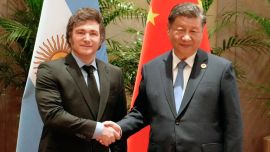Energy producers in Argentina are poised to fare best from the agreement with the International Monetary Fund, analysts in Buenos Aires say.
Narrowing the fiscal deficit by reducing government energy subsidies, which climbed to US$10.9 billion last year, was a key sticking point in talks. Now that a deal – laid out in a memorandum of understanding and pending final approval – has been hammered out, investors are scrambling to understand its impact on Argentine energy assets.
In both the power and natural gas sectors, the flow of energy – and money – involves producers, transporters and distributors. Of the three, producers are likely to feel the biggest positive impact of the subsidy cuts, targeted this year at 0.6 percent of gross domestic product.
The agreement between Argentina and the IMF emphasises passing on a higher proportion of the price of generating electricity and drilling natural gas wells to households and businesses.
Over the last month, since the government said it would peel back energy subsidies as part of the IMF deal, bonds of Argentine energy producers have outperformed sovereign debt. Securities from Pampa Energía SA have returned nearly 2.5 percent and natural gas-fired generator MSU Energy’s 2025 notes returned 1.4 percent, while sovereign bonds due in 2030 lost 5.6 percent, according to Bloomberg’s Emerging Markets Hard Currency Index.
Producers suffer periodically from payment delays when it’s the government, rather than consumers, footing most of the bill. In the power sector, state electricity wholesaler Cammesa is responsible for paying subsidies; in natural gas, the treasury intervenes directly.
“Producers stand to benefit because the state is a bad payer and you always run the risk of delays,” said Lucas Caldi, a credit analyst at Portfolio Personales Inversiones in Buenos Aires. With distribution companies able to pass on more wholesale costs to consumers under Argentina’s IMF-backed plan, and also increasing their own fees, “you improve their business and they have money to pay producers,” Caldi said.
Some of the most testing periods for Argentine power generators to receive payments were the past two years, with MSU feeling the pinch and another company filing for bankruptcy protection. Meanwhile, the second half of the Mauricio Macri administration was particularly bad for natural gas drillers because income streams dried up both from a government subsidy programme and from distributors with regulated billing.
Pampa, Central Puerto SA, Enel Argentina and AES Argentina are among the country’s largest electricity producers. YPF SA, Total Austral, Pan American Energy and Tecpetrol SA are among its top natural gas producers.
There are two major risks to Argentina meeting goals for subsidy cuts:
1. Russia risk
The first – highlighted in the memorandum with the IMF – is the soaring cost of energy amid Russia’s invasion of Ukraine. While Argentine oil and gas prices are decoupled from global benchmarks, the country fills its energy deficit with imports of liquefied natural gas and other fuels. With these international purchases becoming far more expensive, the government’s subsidy bill may even increase this year, according to Konstantinos Papalias, an energy analyst at Puente in Buenos Aires.
2. Currency woes
The second risk is Argentina’s shaky currency, the peso. Power plants with dollar-linked contracts account for about a third of generation, and natural gas prices are also set in dollars. For subsidies to fall, any depreciation of the peso – Argentina intends to maintain the real effective exchange rate steady under the IMF agreement – would have to pass through to consumers.
While the memorandum is clear about the need to regularly update bills – including a hike in March and another slated for June – it doesn’t explicitly mention currency movements, saying only that a concrete medium-term plan will be ready at the end of the year.
“If the currency weakens, the cost of generation rises, and that hasn’t been taken into account in the new proposed pricing scheme,” said María Moyano Hidalgo, a corporate debt analyst at Adcap in Buenos Aires. “It’s going to get out of step very quickly.”
related news
by Jonathan Gilbert & Scott Squires, Bloomberg























Comments